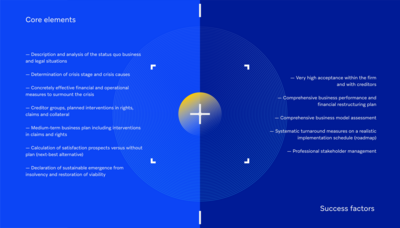Restructuring Report IDW S6 / BGH
Crisis? Surmountable!
Turnaround? Fundable!
Future? Feasible!
Download IDW S6 guidelines
Our books on this topic

Between business sense and legal requirements – restructuring reports according to IDW S6
Companies whose managing directors or board members are required to provide an IDW S6 report usually have a financing problem, have to face tough questions, and need reliable answers.
Questions that meet the legal requirements, but preferably also reflect business sense. In a nutshell: They need a qualified and meaningful testimonial on how seriously viable the company is in future, and they need it fast! For this purpose, the Institute of Public Auditors in Germany (IDW) has developed a standard reporting system (S6), which was last updated in 2018.
En route to a positive going concern forecast with four questions
There are four key questions that must be answered convincingly for a company to be given a certified positive going concern forecast and thus also be able to obtain external capital in the future:
1. Is the company in a position to overcome the crisis situation?
2. What measures must be taken to achieve this?
3. What concrete restructuring concept must be implemented, how, and in what time frame?
4. What does the corresponding financial planning look like?
A certain amount of expertise and experience is required to answer these questions, so that the German Federal Court of Justice (BGH) stipulates the involvement of external specialists. This is mainly also because a corporate crisis brings with it numerous legal implications that must be considered. These include insolvency law and labour laws, to name just two.
Furthermore, the stipulations of the Federal Supreme Court (Bundesgerichtshof) formulated in earlier case law must also be observed. In short, the prognosis for the feasibility of the restructuring must be made by an unbiased and qualified third party.
Our book on the sustainable realignment of companies.
Geschäftsmodelle richtig bewerten.
(“Evaluate business models correctly”)
*Only in German
What is the main issue here?
1. The determination of the the company’s capability to continue as a going concern in view of a possible risk of insolvency.
2. The restructuring capability of the company in terms of its capability to achieve sustained competitiveness.
This means (caution; we are about to get technical) that there is a “capability to continue as a going concern” if the company is fully financed for the duration of the forecast period of the restructuring concept – i.e. it is not at risk of insolvency! With regard to revenues and competitiveness, the following applies: The competitiveness and with it also the re-financing ability of the company is assumed if it can refinance itself on the market. This requires both adequate returns and adequate equity.
Important prerequisite for both “stages of restructuring”: if illiquidity is imminent, countermeasures must be defined and implemented within two to a maximum of three weeks.

Interim conclusion: The purpose of the assessment of companies in crisis is first of all to establish how the crisis came about, and what stage in the crisis the company has reached. It is particularly important to clarify whether there is a risk of insolvency.
For this purpose, the assets, financial situation and profitability of the company must be determined and evaluated. The evaluation of the company’s own figures must of course be carried out in relation to its competitive environment. It must be determined what the normal rate of return for the industry is, for example, and what the equity situation of the company in crisis is.
The actual restructuring work
If this basic information is available and if, after its examination, there is a substantiated prospect of the successful continuation of the business activity (a “positive going concern forecast”), then the actual restructuring work begins.
Planning and presentation
Planning and presentation of an outlook for the reorganised company and its pre-requisite value-creating business model.
Averting pending insolvency
Deriving measures from the above which are necessary to avert insolvency and realise the target status per the stated outlook, with timeline and quantification.
Restructuring plan
Integrated liquidity, earnings and assets planning are extremely important for financing partners.
In addition to this core operational and financial data, the restructuring audit and/or plan should also outline specific answers to questions including how digitalisation will impact the business model.
Conclusion: The quality of the restructuring report following IDW S6 is decisive for further external financing and thus also for the future viability of the company in times of upheaval and crisis.
However, this also means that the competence of the restructuring adviser is critical for the success of the restructuring.

![[Translate to English:]](/fileadmin/_processed_/d/9/csm_SMP_Management-Team_Ansprechpartner_Faerber-Portrait_4_3_1ad5f74e48.png)
![[Translate to English:]](/fileadmin/_processed_/f/9/csm_SMP_Management-Team_Ansprechpartner_Froehlich-Portrait_4_3_6cca2e8ff6.png)
![[Translate to English:]](/fileadmin/_processed_/1/8/csm_SMP_Management-Team_Ansprechpartner_Dussen-Portrait_4_3_4c6702d661.png)
